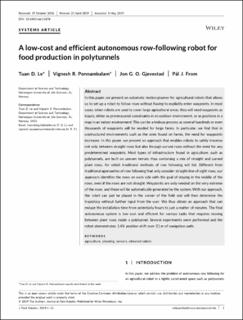| dc.contributor.author | Le, Tuan Dung | |
| dc.contributor.author | Ponnambalam, Vignesh Raja | |
| dc.contributor.author | From, Pål Johan | |
| dc.contributor.author | Omholt Gjevestad, Jon Glenn | |
| dc.date.accessioned | 2020-10-26T08:44:20Z | |
| dc.date.available | 2020-10-26T08:44:20Z | |
| dc.date.created | 2020-01-14T15:00:59Z | |
| dc.date.issued | 2019 | |
| dc.identifier.citation | Journal of Field Robotics. 2019, 1-13. | en_US |
| dc.identifier.issn | 1556-4959 | |
| dc.identifier.uri | https://hdl.handle.net/11250/2684885 | |
| dc.description.abstract | In this paper, we present an automatic motion planner for agricultural robots that allows us to set up a robot to follow rows without having to explicitly enter waypoints. In most cases, when robots are usedto cover large agriculturalareas, they will needwaypoints as inputs,either aspremeasuredcoordinatesinan outdoor environment, oraspositionsina map in an indoor environment.This can be a tedious process as several hundreds oreven thousands of waypoints will be needed for large farms. In particular, we find that in unstructured environments such as the ones found on farms, the need for waypoints increases. In this paper, we present an approach that enables robots to safely traverse not only between straight rows but also through curved rows without the need for any predetermined waypoints. Most types of infrastructure found in agriculture, such as polytunnels, are built on uneven terrain, thus containing a mix of straight and curved plant rows, for which traditional methods of row following will fail. Different from traditional approaches of row following that only consider straight‐line‐of‐sight rows, our approach identifies the rows on each side with the goal of staying in the middle of the rows, even if the rows are not straight. Waypoints are only needed on the very extreme of the rows,and these willbe automatically generated by the system. With our approach, the robot can just be placed in the corner of the field and will then determine the trajectory without further input from the user. We thus obtain an approach that can reduce the installation time from potentially hours to just a matter of minutes. The final autonomous system is low cost and efficient for various tasks that requires moving between plant rows inside a polytunnel. Several experiments were performed and the robot demonstrates 1.4% position drift over 21m of navigation path. | en_US |
| dc.language.iso | eng | en_US |
| dc.rights | Navngivelse 4.0 Internasjonal | * |
| dc.rights.uri | http://creativecommons.org/licenses/by/4.0/deed.no | * |
| dc.title | A low‐cost and efficient autonomous row‐following robot for food production in polytunnels | en_US |
| dc.type | Peer reviewed | en_US |
| dc.type | Journal article | en_US |
| dc.description.version | publishedVersion | en_US |
| dc.source.pagenumber | 1-13 | en_US |
| dc.source.journal | Journal of Field Robotics | en_US |
| dc.identifier.doi | 10.1002/rob.21878 | |
| dc.identifier.cristin | 1772620 | |
| cristin.unitcode | 192,15,5,0 | |
| cristin.unitcode | 192,15,3,0 | |
| cristin.unitname | Seksjon for maskin, prosess og produktutvikling | |
| cristin.unitname | Seksjon for geomatikk | |
| cristin.ispublished | true | |
| cristin.fulltext | original | |
| cristin.qualitycode | 1 | |

